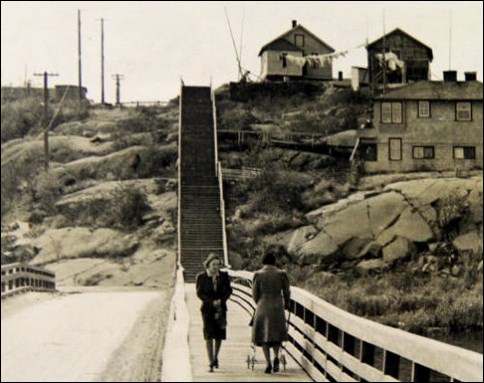Someone once said, “A picture is worth a thousand words.” To this adage I would add, “...and a million memories.”
The photo accompanying this column struck a chord in my memory, so let’s set the scene. The picture was taken circa early ‘40s. The location is obvious to me, for as a child, I descended and ascended those steps many times trudging from Uptown to our little garden plot in Birchview. The photo faces west on the then-Ross Lake Bridge. The rocky landscape to the left of the steps is now Third Avenue. The Third Avenue extension was made circa late ‘40s/ early ‘50s. Who knows?
Regarding the women on the bridge, there were a lot of young married women in Flin Flon at that time, so I would suggest that they are both in their twenties. These women were probably from “down south” or some other distant place, far from their families and home culture. They are wearing dresses, as pants or slacks were not considered “lady-like”. They could have made their purchases at the Hudson Bay store, Ostry’s, The Ladies Smart Shoppe or through the Eaton’s mail order catalogue.
Most women of that era were defined as “housewives.” A few would have had jobs at the Main Street retail stores and offices, at “the Company” offices and the hospitals.
Many women of this era were part of the large contingent who worked on the surface at the mine as replacements for the men who had joined the Armed Forces during the Second World War.
Those women war workers provided an invaluable service to mine production, but as soon as the war was over and “the boys returned,” the women were sent back to their role as housewives. I suspect that many had felt a sense of liberation as they toiled at the mine, thus laying the foundation for the emancipation of women in forthcoming years.
The woman with the baby carriage has probably made up her mind about whether she will face the challenge of bounce-dragging the carriage up the stairs or take the long way around via Mainwaring up Adams and then back over to Third Avenue. The women have no doubt greeted each other. The advancing woman could be thinking that she should–although she may not want to–offer to help get the carriage up the steps.
I went blurry-eyed trying to count the steps. I suspect there were more than one hundred, which would have been a temporary threat to the fame of the Hundred Stairs at Hill Street and Third.
A close look at the houses of that time reveal a number of interesting aspects such as laundry on the clothes line, as clothes dryers were a thing of the future. One of the houses has a pole attached. Many Flin Flon houses of that time had poles (peeled spruce) at each end of the house to support a radio aerial to bring in distant high-power radio stations such as KSTP Minneapolis, KOA Denver, KSL Salt Lake City, KXEL Waterloo and CBK Saskatchewan.
Can you find the outhouse? Houses without water and sewer service required a weekly visit from the vehicle (known as the “honey wagon”) that carried away the you-know-what. The man with that most disagreeable job was called the “honey man”. There is no back lane in this scene, which is not unusual for our rocky town. Thus life was made even more miserable for the “honey man”.
Weekly town garbage pickup was eventually taken over in 1952 by a local, start-up outfit. One man would drive and one or two would walk behind a high-sided truck. With great upper-body strength, the pair outside the truck would dump the garbage up, over and into the truck.
Many houses of that era had wood and coal burning stoves and furnaces, which generated a lot of clinkers and ashes. Residents were advised not to fill the garbage cans with ashes as they became too heavy for the men to lift. Fair enough! By the way, that local outfit was Gardewine and Sons, now a major trucking company with trucks hauling goods across Canada.
Well folks, that’s not a thousand words, but I imagine the picture and words did create a flood of memories.
Got any comments or reflections on this column? Contact Vincent at vincent. [email protected].




